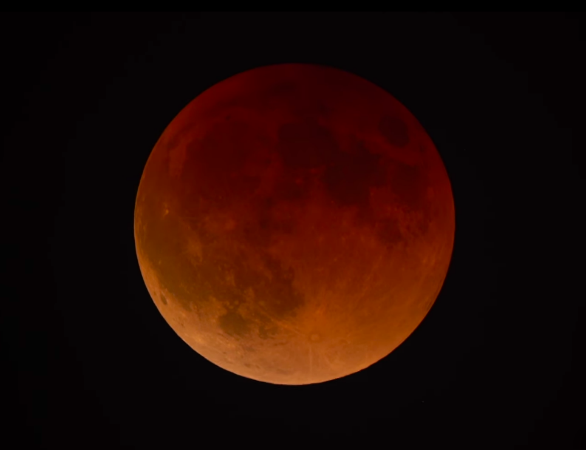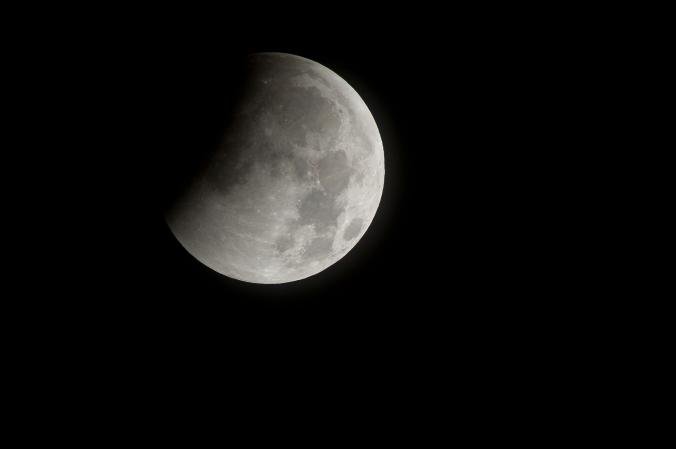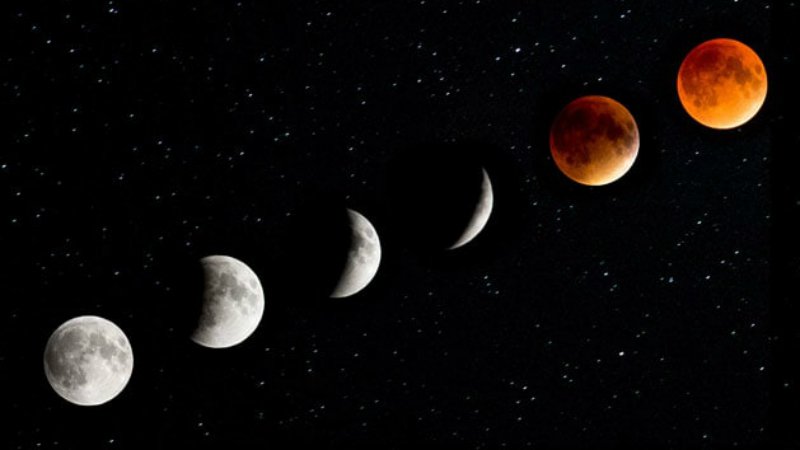
The longest total lunar eclipse of the century will be on Friday night, July 27 2018. While the full eclipse will be over 6 hours, the total lunar eclipse 2018 - when the moon will be in the middle of Earth's shadow - will last for 1 hour and 43 minutes.
This is estimated to be the longest total lunar eclipse for the next century, until June 9 2123. Moreover, this eclipse will be the Blood Moon, a phenomenon that sees the moon take a reddish hue; this happens because the direct sunlight to moon is blocked by the Earth, the moon goes dark and only reflects the sunlight scattered by the Earth's atmosphere. One of the best places to view the lunar eclipse 2018 is India, along with the Middle East, southern China, and eastern Africa.
Lunar eclipse 2018 date, time in Nepal
The eclipse is estimated to start in India at 11:59pm NST on Friday night and the total lunar eclipse 2018 is expected to begin at 1.15 am NST. From 1:30 am to 2:58 am, the moon will be in the middle of the Earth’s shadow and will appear reddish in colour. The eclipse will continue till 5:13 am though the effect will not look as great.
Where to watch lunar eclipse 2018 in India
Due to pollution, people in some metro cities in Nepal may not be able to view the eclipse in its full glory, but those in the countryside should get a good view of the phenomenon. Cloudy skies, however, can block the view of the moon altogether. The Delta Aquariids meteor shower will also be visible to an extent — the meteor shower will be at its peak on July 30, but even on July 27 (the day of the eclipse), the lack of light from moon will allow us to somewhat spot the meteors.
What is so special about lunar eclipse July 2018
The July 2018 lunar eclipse will be the longest one till June 9, 2123. There are many factors for this, one being that the moon will be at the farthest point from Earth in its orbit. This will make the moon appear smaller than regular, and much smaller than it looks during the Super Moon (when the moon is at the closest point in its orbit from the Earth). In fact, this phenomenon of the moon appearing small is called micro moon. The moon in the lunar eclipse will also be passing through the middle of the Earth’s shadow, meaning it will spend the maximum time in darkness, thus contributing to the long duration of the eclipse.
What is a Blood Moon
The lunar eclipse 2018 will also be a Blood Moon, where the moon will take a reddish hue. This happens because the sunlight refracted by the Earth’s atmosphere hits the darkened moon. Because the red wavelengths are scattered less than the blue and violet wavelengths, the moon appears red from our perspective.
How to see Friday’s lunar eclipse, the longest one this century
There’s a Blood Moon on the rise, and people around the world will be able to catch a glimpse of it on Friday July 27th, 2018, when the Moon ducks into the Earth’s shadow. North America, however, is going to miss it — so we’ll have to catch the event on a live stream.
This will be the second Blood Moon (also known as a lunar eclipse) of the year. And it’ll last a whopping one hour and 43 minutes, making it the longest one this century. But the eclipse’s impressive length also means that the Moon itself will actually look a little smaller and dimmer than usual.
That’s because the Moon will be as far away as it gets from the Earth on its elliptical orbit, making the Moon appear smaller. But, the Moon also moves more slowly when it’s that far away, according to Frederick Walter, a professor of physics and astronomy at Stony Brook University. That lets it linger for longer in the Earth’s shadow and stretches out the length of the eclipse.
Folks in regions like the Middle East and much of Europe will get a good view of the eclipse. They’ll see the Moon turn a rusty red — which is where lunar eclipses get their “Blood Moon” nickname. During an eclipse, sunlight has to filter through the Earth’s atmosphere before it can illuminate the Moon. “Blue light bends more than red light, so blue light actually gets scattered out,” Walter says. So the light that the atmosphere projects on the Moon is red, giving it that bloody glow.
Plus, there’s always next year. The Moon will pass through the Earth’s shadow again on January 21st, 2019. And yes, we should be able to spot it from North America.

Get ready for a celestial double feature unlike anything seen in decades: Mars is about to make its closest approach to Earth in 15 years—just as the full moon blushes red in the longest “blood moon” eclipse of the century.
Both the moon and Mars will dominate the overnight hours on July 27 and into the morning of July 28, traveling across the sky beside each other while appearing to be separated by only five degrees, equal to the width of three middle fingers held at arm’s length.
On the 27th, the red planet will swing the closest it has come to Earth since August 2003, allowing sky-watchers around the world to see our neighboring world about as big and bright it can ever get in our skies.
And while you shouldn’t expect Mars to look as big as the full moon, as many online hoaxes in past years have suggested, you will also get to see the actual moon painted red as it undergoes a total lunar eclipse.
During a total eclipse, sunlight shining through Earth's dusty atmosphere is bent, or refracted, toward the red part of the spectrum as it is cast onto the moon's surface. As a result, expect to see the lunar disk go from a dark gray color when the eclipse starts to a reddish-orange color during totality.
Mars In Earth
Mars reaches opposition only once every 26 months, when Earth manages to overtake the planet in its tighter track around the sun. But unlike Earth’s more circular orbit, Mars’s path around the sun is fairly elliptical. That means the distance between the two worlds varies, making some oppositions better than others.
Mars will make its closest approach to Earth for this year on July 31, coming just 35.8 million miles (57.6 million kilometers) away. Such a close approach just a few days after opposition means the July 27 alignment will be your best bet to see the red planet shine its biggest and brightest until 2035.

The previous best encounter occurred 15 years ago, when Mars was a record-breaking 35 million miles (56 million kilometers) distant. Such an epic encounter won’t happen again until 2287.
In addition to offering beautiful views, opposition has traditionally set the stage for robotic invasions of Mars. Because of Mars’s proximity and alignment with our planet, the time around opposition is the best for sending spacecraft, saving travel time and fuel costs. For instance, NASA’s Insight lander launched on May 5 and is headed for a Mars landing this November.
MARS 101
From its blood-like hue to its potential to sustain life, Mars has intrigued humankind for thousands of years. Learn how the red planet formed from gas and dust and what its polar ice caps mean for life as we know it.
Many keen-eyed onlookers may have already noticed the fiery planet growing brighter in our night skies the past few months, making it easy to spot with nothing more than the naked eye. To track down the warrior planet for yourself, go outside after dusk on any clear night and look for the bright beacon rising above the eastern horizon. Mars will glide high over the southern sky throughout the night, setting in the west by dawn.
Most of the time, Mars is not much to look at through a telescope, but that changes during opposition, when the planet becomes a disk filled with tantalizing features. Even a small telescope with about a six-inch mirror will be able to tease out surface details like the southern ice cap (where astronomers may have just found an underground lake) and distinct, dark regions that are windswept, rocky fields.
However, a colossal dust storm has been raging for the past two months on Mars and has enveloped most of the planet, which means telescope views have been a bit hindered. But you can plainly see the effect of all this dust with the naked eye: Mars currently appears to shine with a more yellowish tinge rather than its usual rusty orange hue.
.Agencies
- India’s Lok Sabha Election 2024: 2nd Phase Voting Begins In India
- Apr 26, 2024
- Israel Completes Preparation For Ground Offensive Into Rafah
- Apr 26, 2024
- Students, Police Clash On US Campuses Over Gaza
- Apr 25, 2024
- Israel Procures Tents To Evacuate Rafah Residents For Ground Offensive
- Apr 25, 2024
- Nepal Gifts Two Elephants To Qatar
- Apr 24, 2024
















